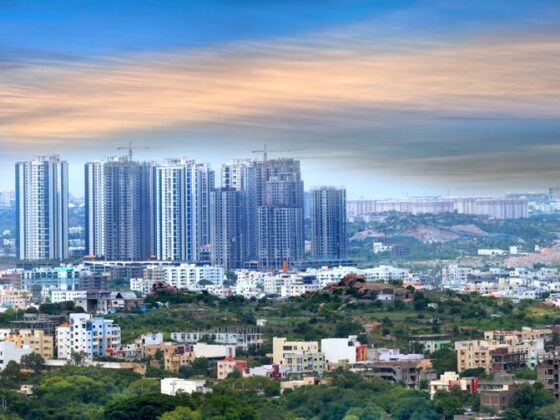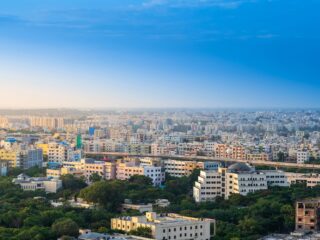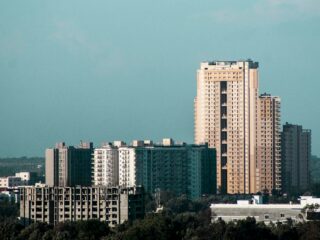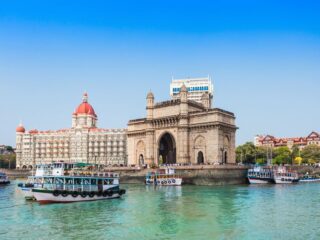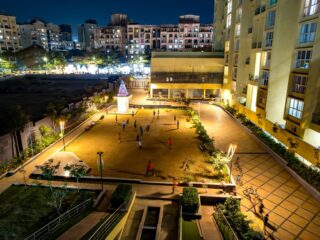Table of Contents
- Ganesh Chaturthi in Pune
- 1. Shri Kasba Ganpati Sarvajanik Ganeshotsav Mandal
- 2. Tambdi Jogeshwari Ganpati
- 3. Guruji Talim Ganpati
- 4. Tulshibaug Ganpati
- 5. Kesari Wada Ganpati
- 6. Dagdusheth Halwai Ganpati
- 7. Hutatma Babu Genu Ganesh Mandal Trust
- 8. Jilbya Maruti Ganpati Mandir
- 9. Shrimant Bhausaheb Rangari Mandal
- 10. Akhil Mandai Mandal
One of the biggest festivals for Hindus, Ganesh Chaturthi or Vinayaka Chaturthi is celebrated in a grand way in various parts of India. It marks the birth of Lord Ganesha, the elephant-headed god, and the celebrations go on for 11 days till the visarjan.
Lord Ganesha was the son of Lord Shiva and Goddess Parvati. Legend has it that Goddess Parvati created a son out of turmeric to guard her home while she took a bath. When Lord Shiva returned home, the young boy Ganesha stopped Shiva from entering which resulted in Shiva beheading the boy in rage. This angered Parvati and to pacify her, Lord Shiva sent Lord Brahma to search for any living being sleeping with its head facing north and behead it. Lord Brahma found an elephant and beheaded it and brought its head back to Lord Shiva. As assured to Parvati, Shiva attached the head of the elephant to the body of the boy and gave him a new life. This boy was then known as Ganpati, the ruler of all beings.
The celebrations for Ganesh Chaturthi goes on for 10 days and the Visarjan on the 10th and the 11th day. This festival is celebrated with much passion and tradition all over India. The people welcome idols of Lord Ganesha into their homes on the first day and offer their prayers and sweets to the god for the next 10 days. Then on the 11th day, the idols are taken in a procession to a nearby water body for immersion.
Ganesh Chaturthi in Pune
Ganpati celebrations have been going on in Pune since the days of Chatrapati Shivaji Maharaj. In other words, Pune has been associated with Ganpati celebrations since the beginning. In 1893, Lokmanya Tilak reinvented the Ganpati celebrations in Pune with the hope of breaking the social barriers in a society where caste played a huge role in everyday life. Now the celebrations of this festival have spread to many parts of the country, but its roots are known to be in Pune.
The whole city takes on a festive look during these 10 days with the lanes and temples decorated and music blaring in every street. Although the idols in Pune are not as humongous as the idols in Mumbai which stand at 30-40 feet, the celebrations in Pune are more about tradition. Tradition is so important that the Ganpati mandals have a priority list when the idols are taken for immersion.
Let’s take a look at the must-visit and best places for Ganpati pandals in Pune:
- Shri Kasba Ganpati Sarvajanik Ganeshotsav Mandal
- Tambdi Jogeshwari Ganpati
- Guruji Talim Ganpati
- Tulshibaug Ganpati
- Kesari Wada Ganpati
- Dagdusheth Halwai Ganpati
- Hutatma Babu Genu Ganesh Mandal Trust
- Jilbya Maruti Ganpati Mandir
- Shrimant Bhausaheb Rangari Mandal
- Akhil Mandai Mandal

1. Shri Kasba Ganpati Sarvajanik Ganeshotsav Mandal
Established in 1893, this idol holds the status of presiding deity among all Ganesh Mandals in Pune. The Kasba Ganpati is the first one to be immersed and is fittingly called the “Manacha Pahila Ganpati” or the most revered Ganpati. The festivities at this Mandal is a must-watch.
Where: 159, Kasba Peth, Pune
2. Tambdi Jogeshwari Ganpati
This is one of the Ganpati’s started by Lokmanya Tilak in 1893. The head of the idol at Tambdi Jogeshwari Ganpati resembles that of an African elephant. This idol has remained the same since it’s inception and has been made by a single family over 4 generations. The Tambdi Jogeshwari Ganpati is known as the ‘Gramdevata of Pune,’ (Protector of Pune). The celebrations at this temple are very traditional so don’t expect any Bollywood numbers or item songs playing at this Mandal.
Where: 33 (A) Budhwar Peth, Pune
3. Guruji Talim Ganpati
This mandal has a unique history of being started by one Hindu and one Muslim family in 1887. Guruji Talim Ganpati is said to be the oldest mandal in Pune which started even before Lokmanya Tilak revived the Ganpati festival. This mandal plays a crucial role in spreading communal harmony since it started. It is given the third preference in the immersion procession.
Where: Ganpati Chowk, Laxmi Road, Pune
4. Tulshibaug Ganpati
Tulshibaug Ganpati is the largest Ganpati idol in Pune and stands at 15 feet tall. The mandal pays respect to the women of the Tulshi Baug market who help to bring in the revenue at his market. Tulshibaug Ganpati has a unique theme every year but they don’t spend much on being lavish. A good part of the donations goes for various social causes.
Where: Tulshibaug, Budhwar Peth, Pune
5. Kesari Wada Ganpati
This pandal was formed in 1893 by Lokmanya Tilak. It has the privilege of being the fifth most honored Ganpati in Pune. This pandal is well-known among locals for its social and cultural activities for children and other devotees.
Where: 250, Budhvar Peth, Shivaji Road, Pune
6. Dagdusheth Halwai Ganpati
This Mandal is one of the most popular mandals among the devotees. Established in 1893, this mandal is visited by celebrities as well as locals. Dagduseth Halwai pandal plays an important role in identifying Pune’s cultural significance. This Mandal also holds the crown of the richest Ganpati in Pune.
Where: Babu Genu Chowk, Pune
7. Hutatma Babu Genu Ganesh Mandal Trust
This Mandal was established in 1970 and is named after a famous freedom fighter. It is believed to fulfill all your wishes and also has a wishing pond, ‘Iccha Poorti Kund‘ where devotees throw coins and make a wish.
Where: Kelkar Road, Narayan Peth
8. Jilbya Maruti Ganpati Mandir
This mandal was established in 1954 and is famous for its lively Ganesh idol. It is also known as ‘Navasacha Ganpati’. This Ganpati idol is also believed to fulfill all your wishes.
Where: Shanipar Mandai Rd, Tulshibaug, Shukrawar Peth
9. Shrimant Bhausaheb Rangari Mandal
This mandal is the oldest sarvajanik mandal set up in India. Established in 1892, this mandal is well known for its eco-friendly idols. This mandal was formed by Bhausaheb Laxman Javale or as he was popularly known as Bhau Rangari.
Where: Bhau Rangari Road, Budhwar Peth
10. Akhil Mandai Mandal
Akhil Mandai Mandal is one of the most important mandals in Pune. This mandal is thronged by thousands of devotees from the city as well as other cities of Maharashtra. It is also well known for its extravagant and beautiful decor.
Where: Budhvar Peth, Mandai, Shukrawar Peth

Ganpati Visarjan
After the 10 days of festivities and celebrations, the 11th day marks the visarjan procession. The idols of Ganpati of various designs and sizes are taken in a procession for immersion. Thousands of people come out on the streets to witness this spectacle and say their goodbye’s to their favorite Bappa. The visarjan of idols which people bring into their homes can be immersed on the 3rd, 5th, 7th or 11th day whereas all the major pandals and mandals do the immersion on the 11th day. Visarjan in Pune is celebrated on a big scale and roads and traffic are closed in particular areas through which the procession proceeds.
Pune’s 5 Manache Ganpati’s are the first in the queue to be immersed according to their order. Kasba Ganpati, Tambdi Jogeshwari Ganpati, Guruji Talim, Tulsi Baug Ganpati, and the Kesariwada Ganpati are the 5 Manache Ganpati’s who are immersed in that order. The procession is marked with performances by dhol tashas and lezim troupes which turns the whole city into a spectacle of culture and tradition. The main spots in Pune to view the immersion procession is all along the riverbanks of the Mula Mutha river with most of the big idols immersed under the Lakdi Bridge and the Natraj immersion ghat in Deccan Gymkhana.
Conclusion:
Pune has a very traditional way of celebrating the Ganpati festival very unlike Mumbai. The city is decorated and you can hear the chants of “Ganpati Bappa Moriya” all over the place. The whole atmosphere during this festival is electric and you have to go and visit the city during this time to actually get a feel of how grand and important this festival is for the Punekars. As they say to Bappa, “Ganpati Bappa Moriya, Pudcha varshi loukar ya“.
You May Also Like: Ganpati Special: Best Places for Zoloites in Mumbai to Witness Ganesh Pandals

